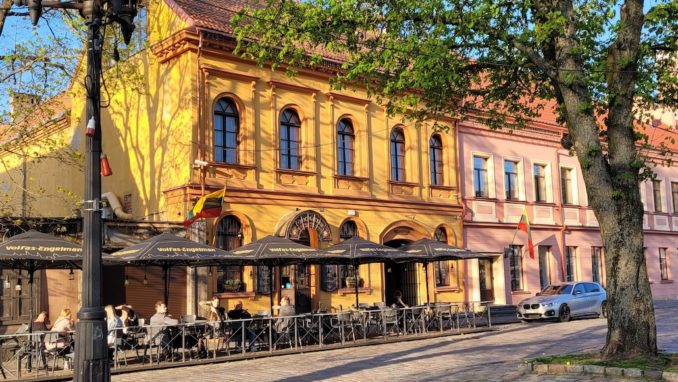
© Novak and Goode 2023, Going Postal
As 2nd cities go Kaunas, seems at least, at first glance, to be a pretty unprepossessing sort of place regardless of whether you arrive by air, road or rail. Arriving by train reveals an industrial vista, whilst driving in from the airport or the national highway takes you past a succession of low-rise houses and warehouses until you get into the centre. At least now the train from Vilnius actually brings you into the city, from 2007 until 2010 the train terminated before a tunnel that had become unsafe, at a wooden platform on the outskirts of the city, grandly named Kaunas 1. Getting into town from there was a very hit-and-miss affair especially at night. The tunnel was rebuilt in 2008/9 using EU funds and the journey time from Vilnius in a modern double-deck train now takes about 1 hour 20 minutes and costs around 11 Euros for a 1st class ticket.
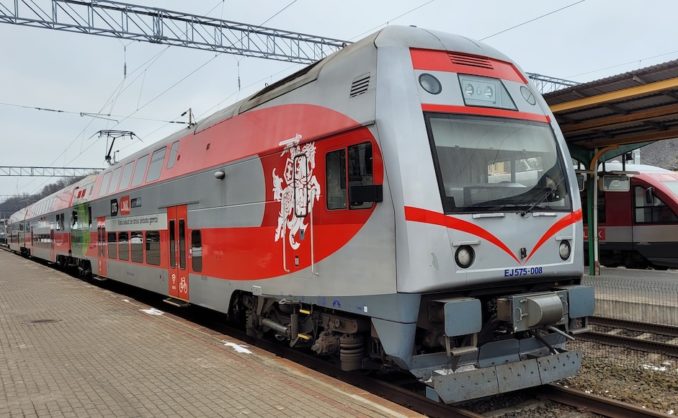
© Novak and Goode 2023, Going Postal
I have been travelling to Kaunas from time to time since 2007 (those of you who might have read other articles that I have written may recall I spend at least a week a month working in Poland or Lithuania). At that time, it was the case that my colleagues always saw Kaunas as the “short straw” option and were only too keen to get onto Vilnius where it appeared there was much more to do. Indeed in 2007 being in Kaunas on a Sunday was a very quiet affair, 99% of the city would be closed and apart from the odd church, museum or hotel bar there was little to do. Today the city comprises some 400,000 inhabitants and was European Capital of Culture during 2022.
However, since the so-called pandemic, I have had to use Kaunas more and more as my entry/exit point to Lithuania as the number of direct flights to Vilnius from the UK has decreased largely due to capacity issues and reconstruction at Vilnius Airport. Kaunas airport is about 10 miles from the centre of town but one can catch a bus from outside the airport which runs nonstop to Vilnius. It is usually more time and cost-effective to do this than to travel into Kaunas city to catch a train to Vilnius. Given the vagaries of the flight timetable, I often find that I have to be in Kaunas the day before my flight or will spend some time there before going onto Vilnius. When I have no meetings, I have used the time to explore Kaunas and the place has started to fascinate me.
In historical terms Kaunas has existed as a city for at least 600 years but the name first appears in 1361, however remains of earlier settlements going back to the 1st millennium BC have been found, but it was in 1408 that Vytautas the Great granted city rights. The buildings in the picture below were found when a hotel development was started in Daugirdas St. No records existed that showed the buildings were there but it is likely they also extend under the adjacent buildings. Development of the site ceased and there are no funds to do anything with these buildings other than to put a tin roof on each and fence them off.
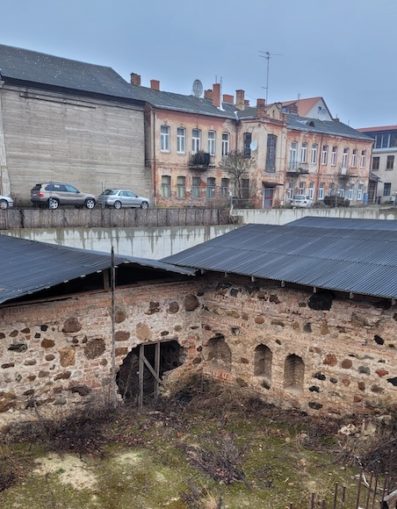
© Novak and Goode 2023, Going Postal
Given its location, Kaunas served as an inland port linking central Lithuania to the sea and therefore Western Europe. In the 17th and 18th centuries Kaunas became a prosperous city and as with many ports, there was smuggling of high-value goods. There is a house on Daugirdas St near to the river that has a very small window in its façade. The purpose of this window was merely to display a candle as a signal when it was safe to land contraband from the river.

© Novak and Goode 2023, Going Postal
The city was part of the Russian Empire from 1797 (Napoleon transited and trashed the city twice, once on his way to Moscow and also on the way back) until 1915 when the Germans invaded. Many Czarist era buildings remain as the city was not only the most westward but also one of the largest garrisons for Russian Empire troops who defended the city via a fortress complex comprising nine modern forts built at the end of the 19th Century (a 10th fort was started in 1913 as part of a planned expansion of the complex but was never completed due to WW1). In the late 19th Century Kaunas became an industrial powerhouse for Lithuania and significant factories were built.
Following the conclusion of WW1 the Russians occupied Vilnius, the capital of Lithuania; following the Polish-Soviet War in 1920 Poland annexed the eastern part of Lithuania which contained Vilnius and therefore the capital of Lithuania moved to Kaunas until October 1939. In turn, this meant that the state institutions also moved to Kaunas and one can find the old interwar Central Bank, the old interwar Parliament Building and so on dotted around central Kaunas. During the interwar period, the population of Kaunas grew by a factor of nine and new river bridges were built along with numerous Art Deco/Bauhaus-style concrete villas for high-ranking government or military officials and wealthy Lithuanians. Kaunas became known as the “Little Paris”. Many of these Art Deco buildings are now on the UNESCO Heritage Register.
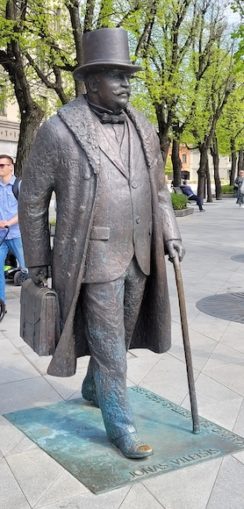
© Novak and Goode 2023, Going Postal
This “renaissance” came to an end in October 1939 when the Soviets “offered assistance” to Lithuania and created five large military bases on Lithuanian territory. In June 1940 following a staged border incident some 200,000 Soviet troops occupied the rest of Lithuania. The Soviets formed a Lithuanian puppet government on June 17 1940 and the Soviet troops were accompanied by units of the NKVD who immediately started to liquidate anyone connected to the interwar republic government (the military, priests, nationalists, industrialists and intellectuals). Alongside this mass deportations to Gulags became the norm, indeed the liquidations by the NKVD were still occurring in the NKVD prison in Kaunas on the day the first German reconnaissance troops entered the City on June 22/23 1941.
The German invasion of Lithuania started on 22 June 1941 as part of Operation Barbarossa, prior to the arrival of the Germans. Lithuanian Nationalists in Kaunas started an uprising against the Soviets and by the evening of 22 June occupied the Presidential Palace, the Post Office, the Telegraph Station and the Radio Station. The Soviets attempted a counterattack against nationalist forces on 24 June but were beaten back. On 26 June Lithuanian Nationalist leaders formed a provisional government and started talking with German officials about working with the German authorities, the talks were abortive but the Nationalists did not disband the Provisional Government until 5 August.
Sometime between 23rd and 28th June a massacre occurred at the Lietūkis Garage complex where NKVD prison motor transport was kept. The event is today contested in terms of the number of those murdered (accounts range between 40 and 120) the dates (some accounts state the 23th others the 25th and/or 27th; others claim multiple days); the identities of those slain is also disputed. Some say those killed were wholly Jewish civilians, others that those who perished were NKVD personnel attempting to flee the German advance (given the proximity to the prison NKVD staff going to the garage where they kept vehicles to flee is possible).
Only eight of those killed have ever been identified by eyewitness testimony as being Lithuanian civilian Jews, the remainder were not known to local Lithuanian civilians who were present. The killings were carried out by Lithuanian Nationalists who beat the victims to death with heavy tools found in the garage. The event was witnessed by a few German troops from the 562nd Bakery Company who did not participate in the killings but did however take photographs.
Over time the facts have been muddied by conflicting documents/testimonies/political claims; Postwar the Soviets claimed it was a Nationalist crime against Soviet personnel and the Jews claimed it was only an atrocity against Jewish civilians; the truth probably lies somewhere between the two. The site of the garage complex has now been largely destroyed by a modern school gymnasium, only a small memorial stone stands on the site. The photographs of the massacre are gruesome and can be found on the internet if that is your taste.
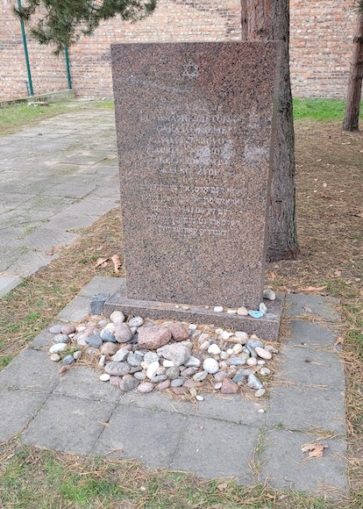
© Novak and Goode 2023, Going Postal
The Germans were driven out of Kaunas in the summer of 1944; in the period following their arrival in 1941 and their departure in 1944 some 50,000 people were killed at the 9th fort and of these some 30,000 are thought to be Jews.
On 1st August 1944 the Soviets returned and the murders and deportations of Lithuanians continued until 1956. Kaunas became a location for protests against the Soviet occupation periodically until 1991. During Soviet times the city retained its reputation as an industrial centre and one of the more unusual repurposings was the utilisation by the Soviets of an Art Deco church (Lord Jesus Christ Resurrection Basilica) as a radio/tv factory which was reconsecrated in 2005.
Geographically Kaunas stands at the confluence of two major Lithuanian rivers; the Namunas and the Neris. Given the joining of the rivers creates a pinch point it is not unknown for the Old City to flood from time to time, however modern flood defences have largely negated this risk. The Church of Vytautas the Great stands adjacent to the river and has a marker attached showing the highest point ever reached by the flood waters.

© Novak and Goode 2023, Going Postal
The city sprawls away from each of the riverbanks and rises on two sides into steep hills. Kaunas Old City is located at the point where the rivers converge and comprise a square, a number of churches, a castle and a rotuse (town hall). The buildings mostly range from the C15th to the Czarist era. In the summer it is pleasant to sit outside of one of the cafes in the square, taking perhaps a small beer and a meal.
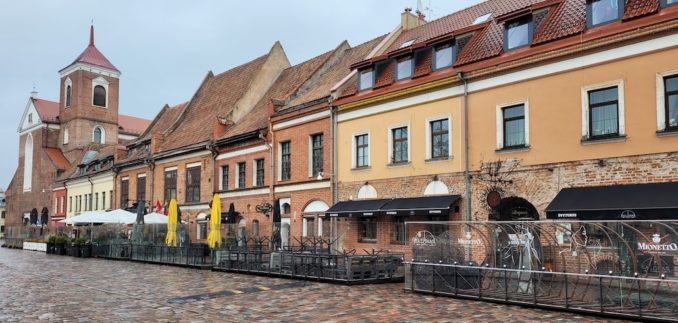
© Novak and Goode 2023, Going Postal
In the winter all the outdoor seating disappears and in December a Christmas tree and some seasonal stalls appear.
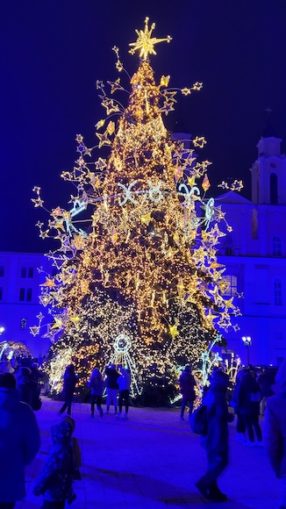
© Novak and Goode 2023, Going Postal
Leading out of the top right corner of the square (with Daugirdas St at your back) past the church is a cobbled street; Vilnaius Gatve (Vilnius St) that leads to a pedestrian underpass. About 300 yards after the underpass, you join the bottom of the main street Laisvės Alėja (Freedom Avenue). At 1.7km it is the longest pedestrian street in Eastern Europe and leads all the way to St Michaels Cathedral which was built in Czarist times for the use of soldiers from the Kaunas fortress garrison.
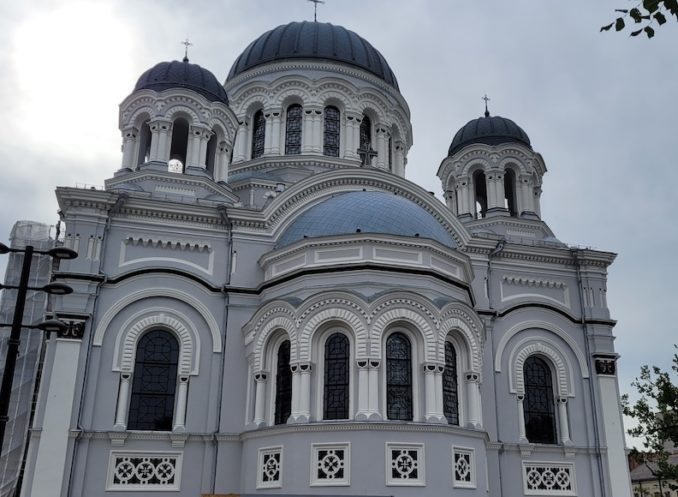
© Novak and Goode 2023, Going Postal
Laisvės Alėja is car-free but is crisscrossed with roads every few hundred yards. You could easily spend half a day leisurely walking from the Old City to St Michaels stopping for lunch on the way and looking at the Art Deco/Czarist buildings.
I recall one of my early visits in around 2008 when I stayed over a weekend in a hotel that faced directly out onto Freedom Avenue. On the Saturday after breakfast my colleague reported that the whole of the avenue had been turned into a market so we went to have a look. It turned out to be a yearly event when all the country crafts people came into Kaunas to sell their wares; there was a lot of honey, cheese and bread and things made from wood and so on; we had a look around and retired to the hotel bar facing directly onto a market stall selling pieces of animal skins. The stall was operated by a man and wife, whenever the wife disappeared, he scooted into the bar ordered 50g of neat vodka necked it and went back outside. As the day progressed the wife would come and look in the cash box, shake her head and wander off to get her next purchase and he would zoom into the bar. By about 3 pm he was rather wobbly and when the wife returned there was much shouting, she stormed off and he staggered into the bar for another shot. We were now watching events with no small degree of interest. He was halfway through trying to sell a piece of deerskin to a couple of young ladies when he lost his footing and hit the ground like a stone; by now we were besides ourselves with laughter. The wife returned saw the stallholder laying on the ground, kicked him in the guts and stormed off again.
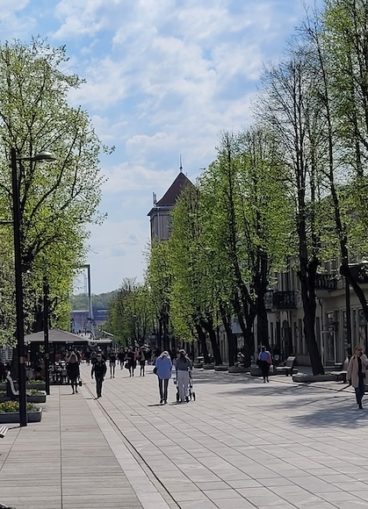
© Novak and Goode 2023, Going Postal
Talking of lunch, one should always look out for a sign outside an eatery announcing “Dienos Pietus” which loosely translates as daily lunch. Typically, this is a short menu that changes each day and will usually offer a filling two-course lunch from a selection of say six to eight items for between five and seven Euros. In Kaunas there are numerous cafes, restaurants and coffee shops around the Old City Square and all along the route I have outlined above from the square to St Michaels and I am certain you will easily find something you like. Coffee shops are popular and one of the best is the Holy Donut, this is a chain serving cakes and meals including a not-too-bad full English breakfast.

© Novak and Goode 2023, Going Postal
A two-course evening meal can be found for less than 15 Euros in many of the restaurants if you avoid the international chains. My favourite is Berneliu (The Shepherds) they have a few restaurants across Lithuania (two in Kaunas; one near the Old City Sq. the other near St Michaels Cathedral) and even a couple now in London.
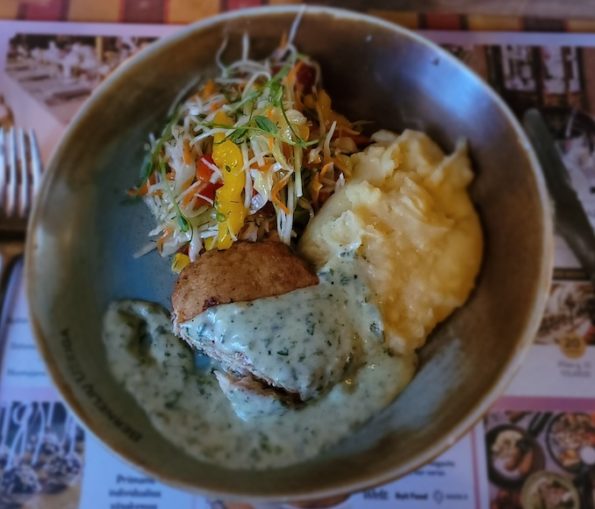
© Novak and Goode 2023, Going Postal
In terms of accommodation, you will find many hotels and apartments on the usual “Booking” type sites. I would recommend you stay as close as possible to either Freedom Avenue or the Old City Square. If you do so then the whole centre of Kaunas is easily walkable (and flat), this is important as at peak times the traffic can be horrendous and crossing the river over any of the bridges can take ages. There is also a one-way system in the centre that means although a journey may look to be a short distance on a map a taxi has actually to drive along a longer route to get you to the destination. A very useful app for ordering a taxi is called Bolt, it tells when the taxi will arrive and how much the journey will be; the pricing is variable according to traffic density and time of day but it is usually much cheaper than hailing a cab.
I would say you can easily see most of Kaunas over a long weekend including say the 9th, Fort; there are numerous on-line guides for inspiration. However, the Kaunas forts are a subject in themselves and I would say that to visit and explore all nine of them would easily fill a week. A short overview of the Forts is here: https://visit.kaunas.lt/en/kaunastic/a-quick-guide-to-kaunas-fortress/ I would say the 9th, 6th and 7th are the most visitable as they also contain museums (there is also a museum nearby the 4th Fort), the others are in varying degrees of disrepair and the 2nd Fort especially is considered to be potentially dangerous due to possible live munitions. I have previously posted an article on here about the 1st Fort and over time I hope to add other Fort related articles.
Kaunas does however possess one thing that you will not find in any other of the ex-Soviet Baltic states and that is a brick-built mosque located in Ramybe Park (10 mins walk from St Michaels Cathedral); (there are three others in Lithuania built of wood).

© Novak and Goode 2023, Going Postal
The mosque was built to serve the needs of Muslim Tartars serving in the Czarist Army and stands within the area of a former Muslim cemetery (now mostly cleared of graves, although some local claim this was done poltergeist style) that was used to bury Tartars and Turkish POWs. A wooden mosque was built originally in 1906 but was replaced by the one pictured in 1930. In Soviet times in was used as a library and also as a circus and did not reopen until 1991. It is used but the congregation is small and I have never seen it open.
The main carriers to Kaunas are Ryanair and Wizz Air flying from Luton and Stansted; Ryanair also operate from some of the other provincial airports (Bristol and Liverpool) but services alter by season/whim so check. A reasonable four-star hotel is around 60-70 Euros a night for a double room and flights can be around £40 each way depending on time of year and extras selected.
Well, for a postcard I have managed to fit rather a lot on the back but now dear reader room has finally run out.
© Novak and Goode 2024



